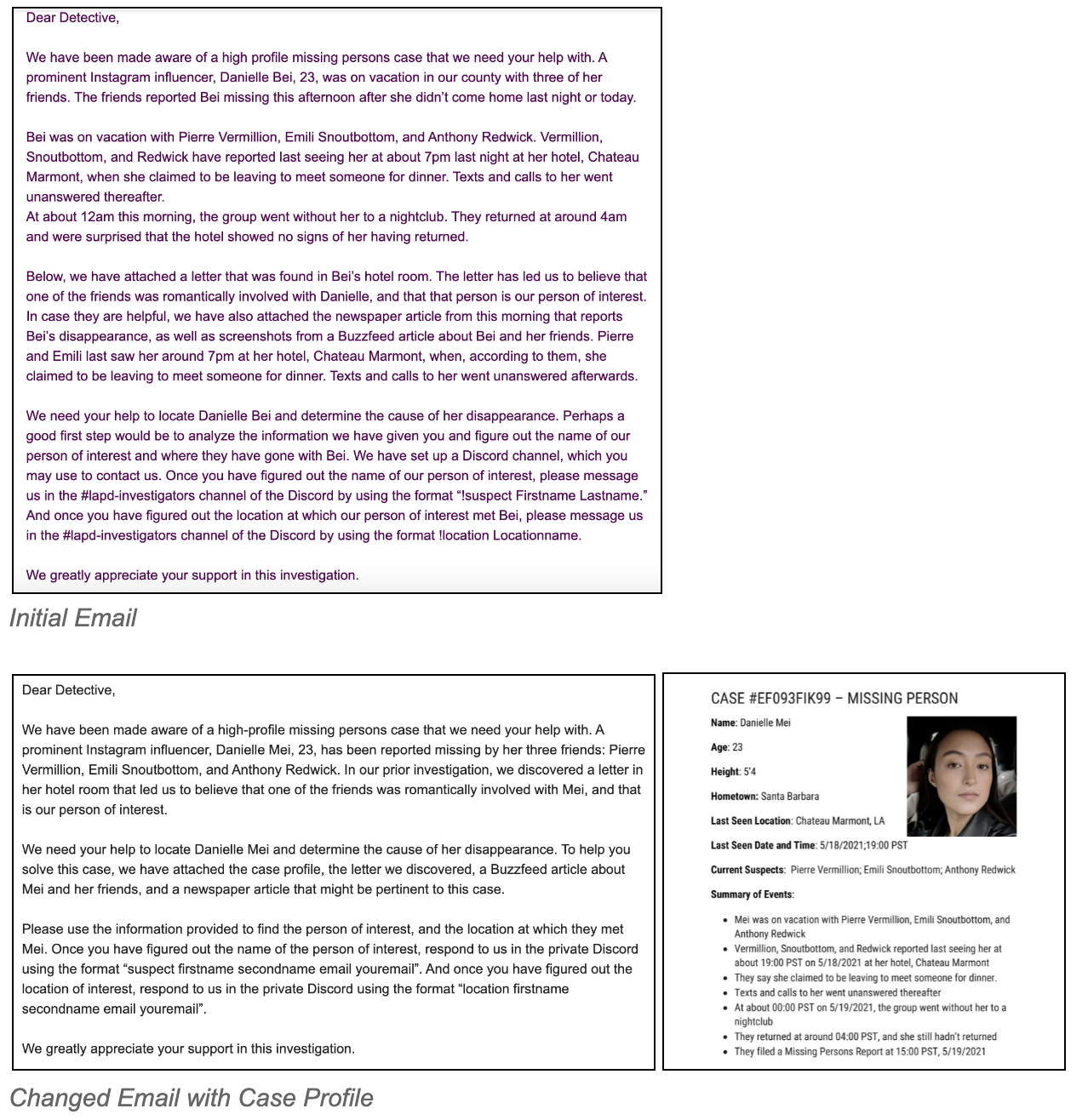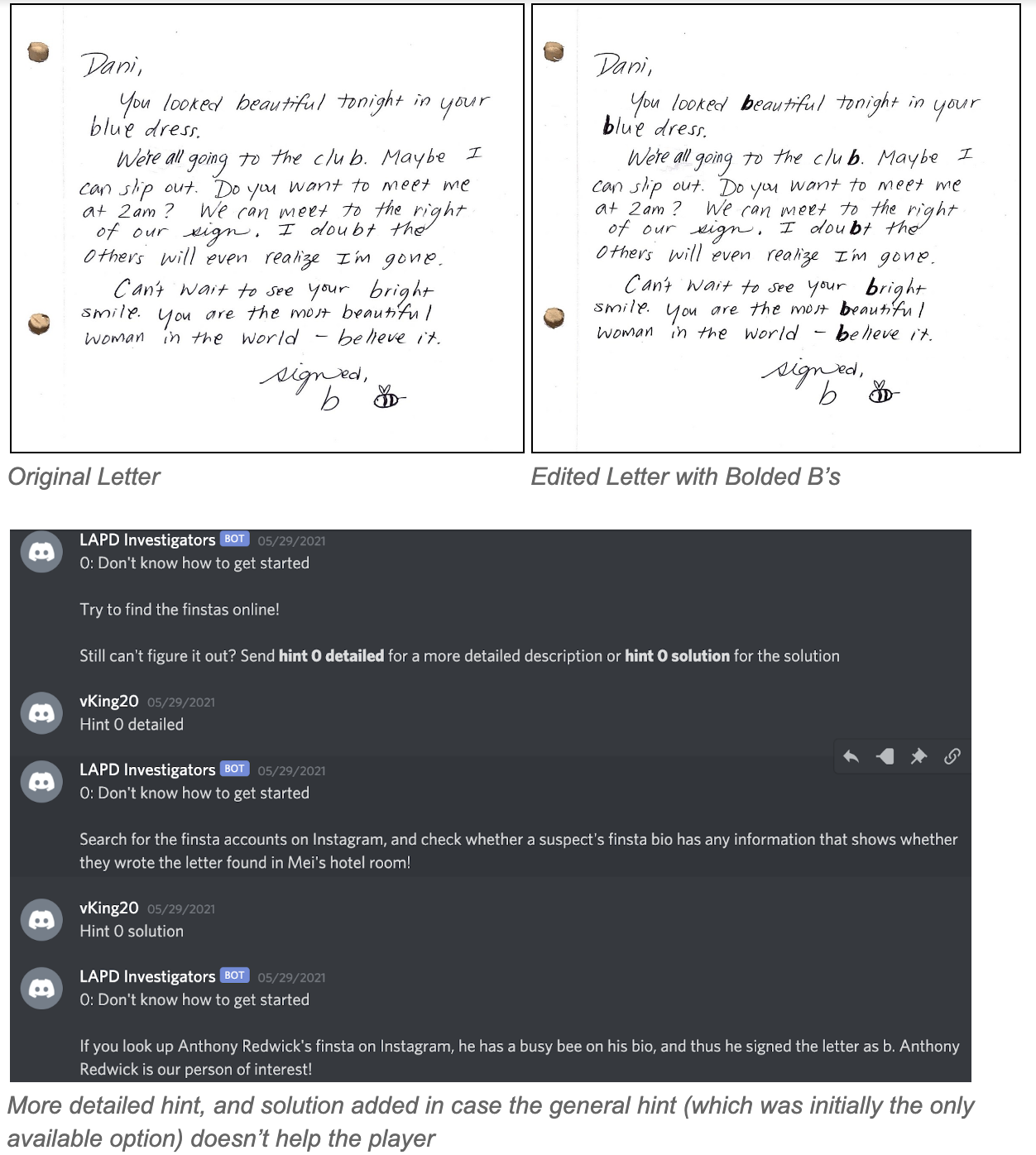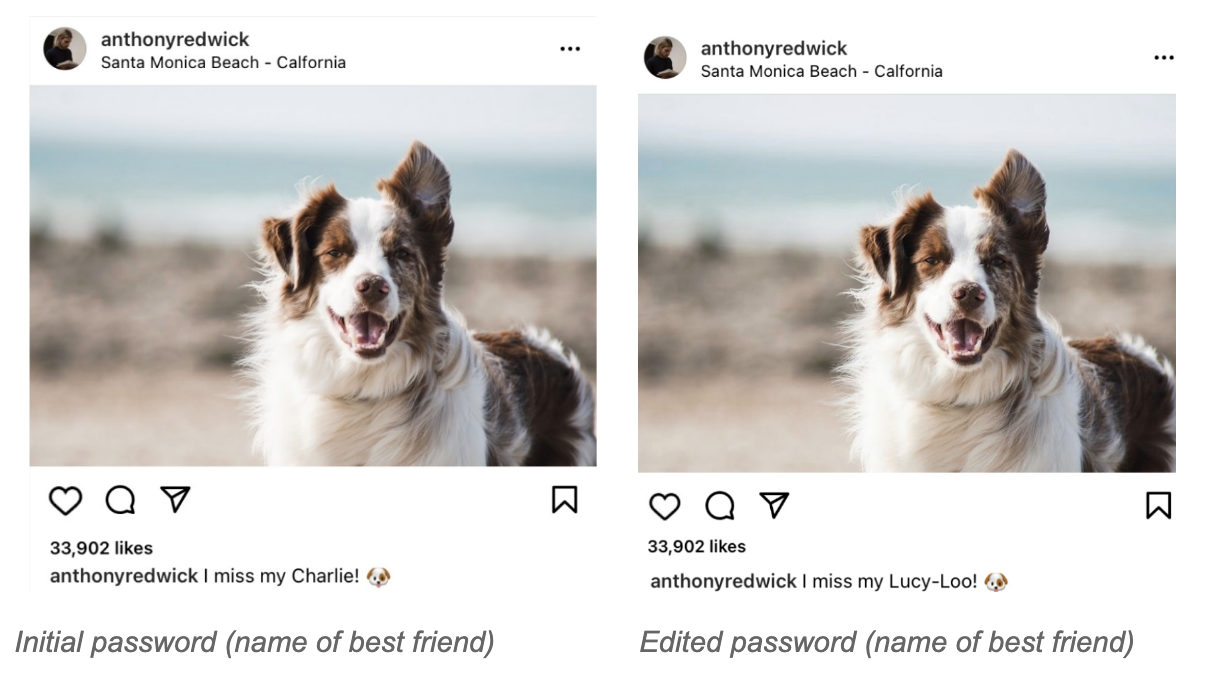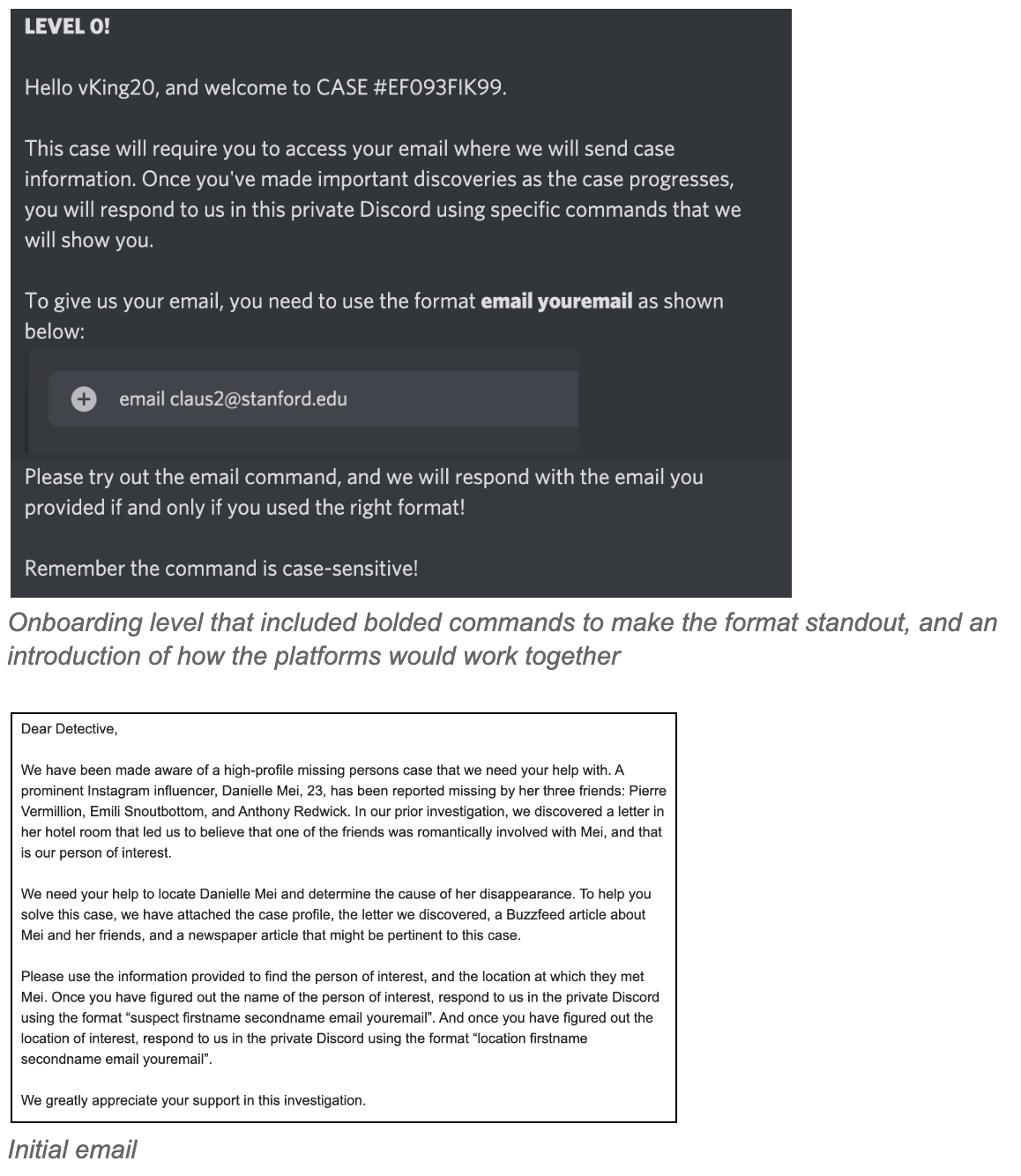
Olivia Brown, Andrea Dahl, Julia Jorgensen, Claus Omolo, Mary Zhu
Artists’ Statement
No Trace was inspired by physical escape rooms and the recent trend of mailed escape-room-style mysteries. We specifically wanted to create a fully-digital escape-room experience, so that people who are physically separated from each other by the pandemic could play No Trace together. Our goal was to build a believable mystery that extends to many corners of the online world. Where would clues about a missing social media influencer pop up? Perhaps on her Instagram account, on Buzzfeed articles about pop culture news, in newspapers, or in voicemails. At moments when a physical escape room might require you to find keys to locks, No Trace requires you to find passwords to Instagram accounts. Thus, by combining classic escape-room-style puzzles with a fully-digital world, No Trace offers a captivating and believable mystery for the digital age.
Main Design Choices
When conceptualizing No Trace, we particularly considered the target audience, tone, and types of fun that we wanted the game to have. Below, we describe our goals for each of these categories, as well as the design choices we made to support those goals. As a note, we specifically crafted the Formal Elements to support the types of fun we chose; since it is lengthy, it occupies its own section.
Target Audience
Building a fully-digital escape room allowed us to hone in on a target audience that we are familiar with: online true-crime sleuths and social media aficionados. We especially targeted people who are interested in true crime and escape rooms. Additionally, the difficulty of our game is targeted at intermediate to advanced puzzle-game players.
To craft our game for this target audience, we used technologies and websites that are popular among this crowd, such as Instagram and Buzzfeed. We also played into tropes of crime/mystery procedures, such as working with the LAPD and tapping phones. We hoped this would make the game genre-consistent for fans of crime/mystery stories.
Our main characters are social media influencers, as they are an archetype our target audience would be familiar with. We hoped that using this known trope would make the game feel approachable. We then twisted this influencer trope to incorporate our jewel-theft storyline; in doing so, we hoped to make our game mysterious and unpredictable for our target audience.
Tone
The tone of our game comes from two themes that our target players are familiar with: celebrity/influencer culture and mysteries. With the tabloid-esque Buzzfeed article and the bright Instagram accounts, we leverage players’ mental models of celebrities to cultivate a “rich-and-lazy-influencer” aura around our characters. Additionally, because of the ominous nature of a missing person, as well as the dark background of the Discord, the black-and-white newspaper, and the suspenseful music, the game achieves an atmosphere of mystery.
Formal Elements
We used our Formal Elements to develop the game’s intended aesthetics of fun. Here, we lay out our decisions for the Formal Elements before explaining how they contribute to the game’s aesthetics.
Objective: The overarching goal of the game is to find out exactly what happened in the disappearance of our missing person, Danielle. However, we set two subgoals for our vertical slice: (1) identifying the first suspect (the author of the “bee” letter), and (2) figuring out the location at which Danielle met the suspect on the night of her disappearance.
Both of these subgoals, as well as the overarching goal, fall into the Solution category of Objectives.
Players: This is a single- or multi-player game, where all players take on the role of an off-site detective who has been hired by the LAPD. If multi-player, the players work cooperatively to solve the mystery, and all players have the same role within the game and receive the same information. We chose this setup to be similar to an escape room or a group of detectives, where all players contribute their personal skills to the group goal.
Conflict: The game has a Player vs Game format; the player must find and solve puzzles in the game, and does not compete with any other human player.
Procedures:
- The player joins the Discord via the invite link, which gives them access to the No Trace game server and the lapd-investigators text channel. Here, they also gain access to the game’s playlist.
- The player joins the lapd-investigators voice channel, and ensures the microphone is enabled.
- The player types start in the lapd-investigators text channel.
- This activates the Onboarding phase of the game. Here, the player completes the Tutorial, where they learn how to use the Discord commands before starting the game. Following the Tutorial tips from the Plants vs Zombies talk, we broke the Tutorial text into small chunks, so that the player reads a short sentence and then must type a command correctly before receiving the next chunk of information. In addition, we included visuals to help players navigate Discord.
- First, we show players how to get to the DMs where the game will take place:
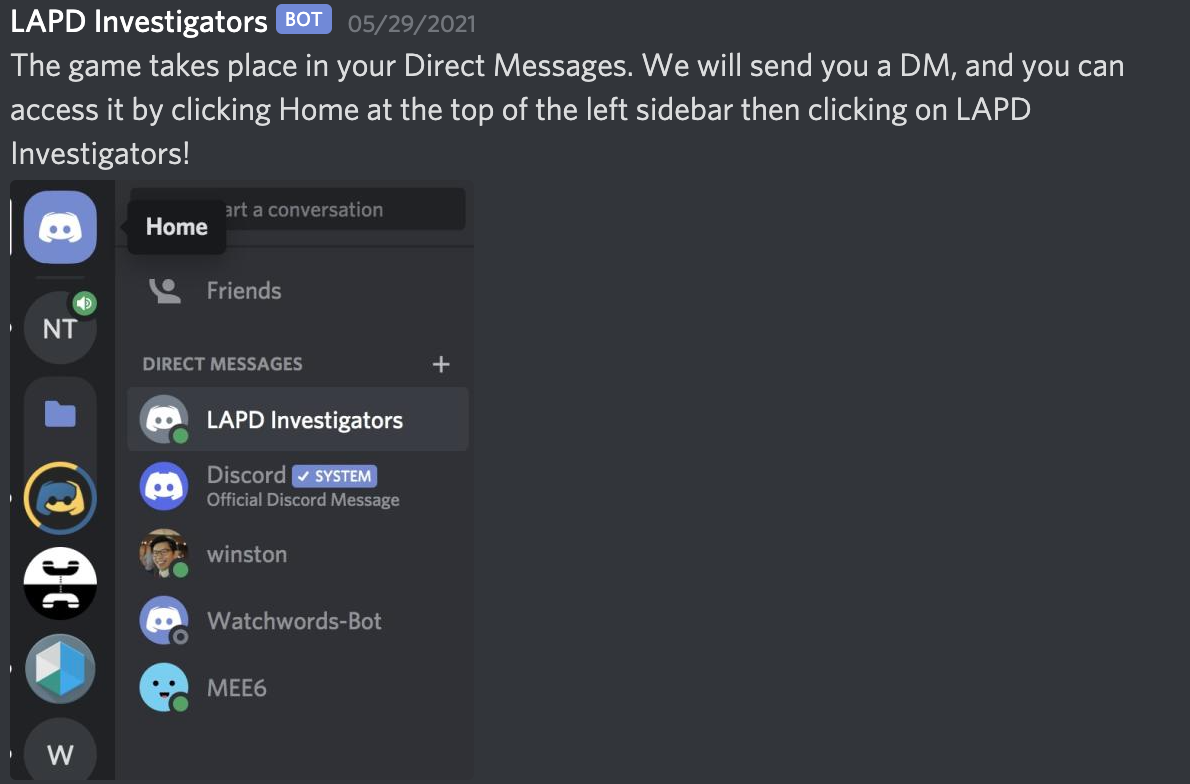
- We also remind the player to join the voice channel (and how to do it) in order to listen to the game’s music:
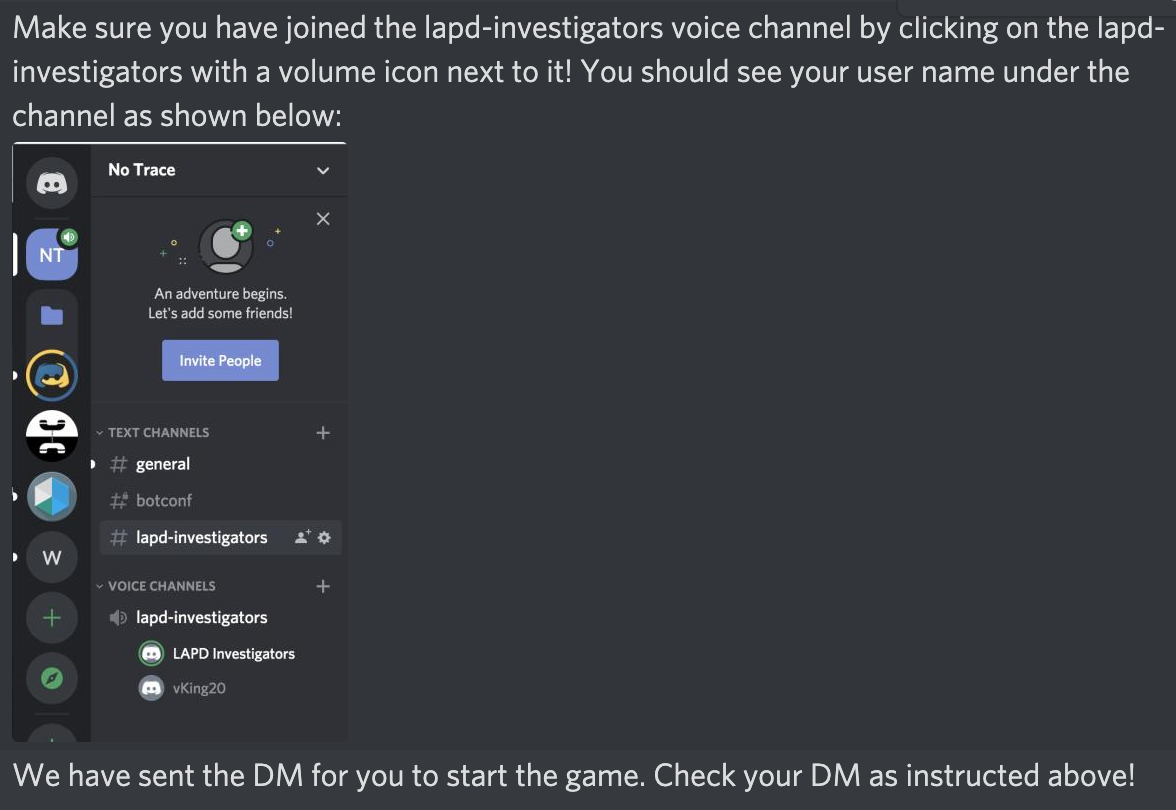
- First, we show players how to get to the DMs where the game will take place:
- Having completed the Tutorial, the player progresses to the actual game, which they complete by following instructions given by the LAPD Investigators. The specific chronological and textual orders of the story are detailed in the Narrative section in Types of Fun below.
- During gameplay, the game’s core loop involves receiving a small-scale goal, searching for clues, solving the clues, proposing a solution, and discovering the consequences of your actions (i.e. whether you can move onto the next puzzle, or are wrong and must try this puzzle again).
Rules:
- When using the Discord, the player must follow a specific command format in the responses to the LAPD Investigators e.g email [player’s email].
- The player needs access to an email to play the game.
- To progress through the game, the player must solve the game’s puzzles.
- The player may access hints whenever they get stuck by typing hints in the Discord channel.
- The player may access an inventory of the correct command formats by typing help.
Resources: The hints and evidence are the main resources of our game. We give players evidence materials (a newspaper article, a Buzzfeed article, a letter, and a case file) at the beginning of the game. As players solve puzzles, they receive more evidence, which include voicemail and interview audio files and Instagram private DMs. We specifically designed our game to include a diversity of formats to prevent monotony. Players can access hints in case they get stuck, and they may use an unlimited number of hints. Players also receive unlimited time and guesses (except in the case of the Instagram password). Thus, players are only limited by their own time and resilience.
Boundaries: After joining the Discord, players enter our “Magic Circle”, which encompasses the entire internet but is anchored at the Discord and the player’s email. The expansive magic circle makes No Trace unique. In traditional escape rooms, all materials needed to proceed with the game are contained within the game’s platform. No Trace, on the other hand, combines platforms that players use in real life (e.g. email and Instagram) with other fictional materials created just for the game. This allows players to imagine that the game world could inhabit the entire real world; materials for the game could be hidden anywhere on the internet.
Outcome: Players are either right or wrong when they guess the suspect or location at each step of the game. If they get either of these wrong, they can continue guessing until they are right. For the entire game, the player faces the following two outcomes:
- Identify all correct answers to the questions posed on the Discord platform and complete the slice of the game.
- Remain stuck at a stage despite the hints provided.
Types of Fun
Fantasy
At the beginning of the game, players learn that they are investigators working with the LAPD to solve a crime. Thus, they are immediately given a role to play. Throughout the game, the LAPD continuously interacts with the players through the Discord bot and emails, and always treats the player as a fellow investigator. This prevents the players from forgetting their role in the game world and thus losing the Fantasy element of the game.
Moreover, the simplicity of the game’s Procedures strengthens this aesthetic. On Discord, the player simply types in the one-to-two- word answers to puzzles. By only allowing these simple interactions, the game’s working mechanics fixate the player’s attention on the presented artifacts, enveloping the player into the game’s world.
The game’s core loop, chosen for its similarity to a classic mystery loop (wherein detectives receive a goal, search for clues to move forward, and try new methods when they get stuck) also strengthens the player’s fantasy of being a real detective.
Finally, the visual aesthetic of this game is based on maintaining as real-world an ambience and environment as possible. All of the Resources presented to the player (e.g. the newspaper page and Buzzfeed article) look as realistic as possible. This blurs the Boundaries between the game world and the player’s own world.
Narrative
No Trace is an embedded narrative. In the chronological order of the narrative, the players, playing as investigators, follow trails of online clues to piece together the textual order. In the textual order, a group of social media influencers run a jewel theft operation until one of them tries to take it over and subsequently goes missing.
We held a team brainstorm session to come up with a chronological order of the narrative, and a textual order of the narrative. Our brainstorm doc can be accessed here: https://docs.google.com/document/d/1QqXJjhyXLI6rPv4oMPyYuq2jbXVQwN_jYx9LyYAXgbk/edit
The final version of the narrative can be accessed here: https://docs.google.com/document/d/1nuOc7OhBLSXdNr6LAu3CXk4ku8MN6Qdl7SF-WH5y6oQ/edit
The immersive Fantasy aesthetic makes the narrative believable for the player. This, as we discovered in our playtests, allows the player to become invested in the characters and plot.
The Objective of finding Danielle instills a sense of urgency in the player from the outset, motivating them to want to complete the narrative. The Player vs Game form of Conflict draws the player deeper into the challenges presented by the puzzles introduced throughout our slice; rather than fostering competition between the player and other players, the game enables the user to focus solely on cracking the puzzles and advancing the game’s narrative. Finally, the Outcome of the slice of our game teases the next part of the narrative, further intriguing the players.
Discovery
As players progress through the game, they are guided to more areas of the game world–or more accurately, to more corners of the real world, like Instagram, that the game inhabits. As they discover new resources, the game world that is available to them widens. For example, once players access a particular Instagram page, they can also explore that page’s DMs, as well as Instagram pages that that page follows. The Procedures and Rules, which shape the game as the narrative is unraveled based on the progress made by the player, are loose enough to encourage the player to think outside of the box when it comes to finding solutions to the puzzles in new places on the internet.
Challenge
Each step in the chronological order of the narrative contains an obstacle, as players must enter the correct keywords into the Discord to unlock the next clue. For example, at one point in the game, to figure out a keywords, players must decode a letter (i.e. get around the obstacle of the code).
Design Challenges: Balance
-
Challenge Level
Since No Trace can be played by just one player and does not include objects that players can choose between for different cost-benefit tradeoffs, we focus here on only the first aspect of balance from the Game Design Concepts article: whether the challenge level is appropriate for the audience.
As we explain in our Target Audience section below, our players are advanced puzzle-solvers who enjoy crime/mystery games. Thus, we did not want any of our puzzles to be trivial. However, it was also important that no puzzle be so difficult that players grow frustrated and want to quit the game. Following the tips on difficulty curves that we received in lecture, we tried to begin with our easiest puzzle (determining the Person of Interest from a bee symbol in his Instagram bio) and then “zigzag” upwards; puzzles in general became more difficult, but not every puzzle is more difficult than the previous one.
We then fine-tuned the difficulty of our puzzles during playtesting. After our first playtest, we increased the difficulty of the first puzzle (figuring out the Person of Interest); after another playtest, we decreased the difficulty of the “bee” letter puzzle. We also added a Hints system so that players can customize the difficulty of their own experiences by asking for hints to specific puzzles. When first prompted with a hint, the system delivers an attempt to orient the player in the right direction. If the player is still stuck and prompts the system for more hints, more obvious hints are progressively given.
During the design process, we also used playtesting to fine-tune the game’s balance in the following ways.
-
Too Much Reading vs Too Little Backstory
We worked hard to find the minimum amount of reading material we could give players at the beginning of the game that would still provide them the necessary backstory and clues.
Our game requires setup: initially, to brief the player on the case, we created an email from the LAPD and the “bee” letter. To introduce the jewel theft, we created a newspaper article that references the main case and the theft. To integrate more of the internet into our game, we created a Buzzfeed article. Having all of these resources meant that the player had to read a good deal of text at the beginning of the game, which was time-consuming. After noticing this during playtesting, we rewrote all of the materials to rely more on pictures than text. Most notably, we changed the initial prose-form email from the LAPD into a bullet-point case file.
-
Time Delays: Realism vs Boredom
At two points in our game, the player sends information to the LAPD investigators, who must perform an action and respond to the player with information. These actions (tapping a phone and interviewing a waiter) might realistically take hours. However, we did not want to make the player wait this long; thus, we implemented a 30-second time delay between the player telling the investigators what to do and the investigators’ response. This seemed to work; no playtester complained about either boredom during those wait times or lack of realism (although several complimented the speed of the investigators!).
-
Types of Puzzles
Finally, to keep the game interesting and appeal to people with different tastes in puzzles, we made sure to include different types of puzzles. For instance, some of our puzzles, like the one where players must find the name of Anthony’s best friend, are “searching” puzzles–players explore the game world to find the answers. Other puzzles, like the “bee” letter, are more traditional decoding puzzles.
Playtesting and Iteration
Playtesting was crucial in our ability to balance the above categories. We had four in-class playtests where students in our class worked together in groups to play our game. Additionally, each of the five members of our team separately moderated a playtest outside of class. This gave us a good variety in both player experience (beginner through advanced) and the number of players working together on the game (1-3). Below is a summary of each playtest and checkpoint, including observations and improvements we made from each one.
Checkpoint 1: Concept Doc (4/4/21)
Feedback:
- Narrow down the platform early on and nail the mechanics quickly. (How will people experience the escape room? Who’s running the escape room? Is it self-run or does it need a game master?)
- Without boundaries, we risk making puzzles that are far too big in scope.
Results:
- We decided to utilize Discord as our key platform since it was important to have a platform that can anchor “the magic circle” for the player.
- The game would be self-run by having a bot acting as the LAPD Investigators that would interact with the player.
- We decided to make puzzles that would only utilize emails and Instagram thus restricting the boundaries of the game to the three platforms.
In-Class Playtest 1 (4/6/21)
Observations:
- Because out of the given four suspects, Brad’s name was the only name that started with “B”, the players immediately guessed that he was the “bee” in the letter.
- Since the Instagram accounts were linked in the initial email, players immediately knew to investigate Brad’s Instagram account. In fact, they never needed to look at the other accounts. One player mentioned that Brad being “bee” was so obvious that it could be a red herring.
- The Discord worked well for the players, but it took them out of the magic circle, as they did not understand how the Discord was incorporated into the game’s story world.
Changes:
- To increase the difficulty, we removed the Instagram accounts from the initial email, so that players would have to find the accounts based on the suspects’ names.
- To increase the difficulty, we changed Brad’s name to Anthony so that it no longer started with “B.”
- To preserve the “magic circle” and provide more backstory, we added a line to the initial email explaining that the LAPD set up the Discord to help the player navigate the case.
In-Class Playtest 2 (5/13/21)
Observations:
- Because we removed the links to the characters’ Instagrams from the email, the players never thought to look up their Instagram profiles.
- They asked for a hint and we told them they could use the internet, but they did not realize that they should access Instagram from the internet.
Changes:
- To nudge the players towards looking up the influencers on Instagram, we modified the Buzzfeed article so that it mentioned that although the influencers’ public accounts were deleted, their private accounts still existed.

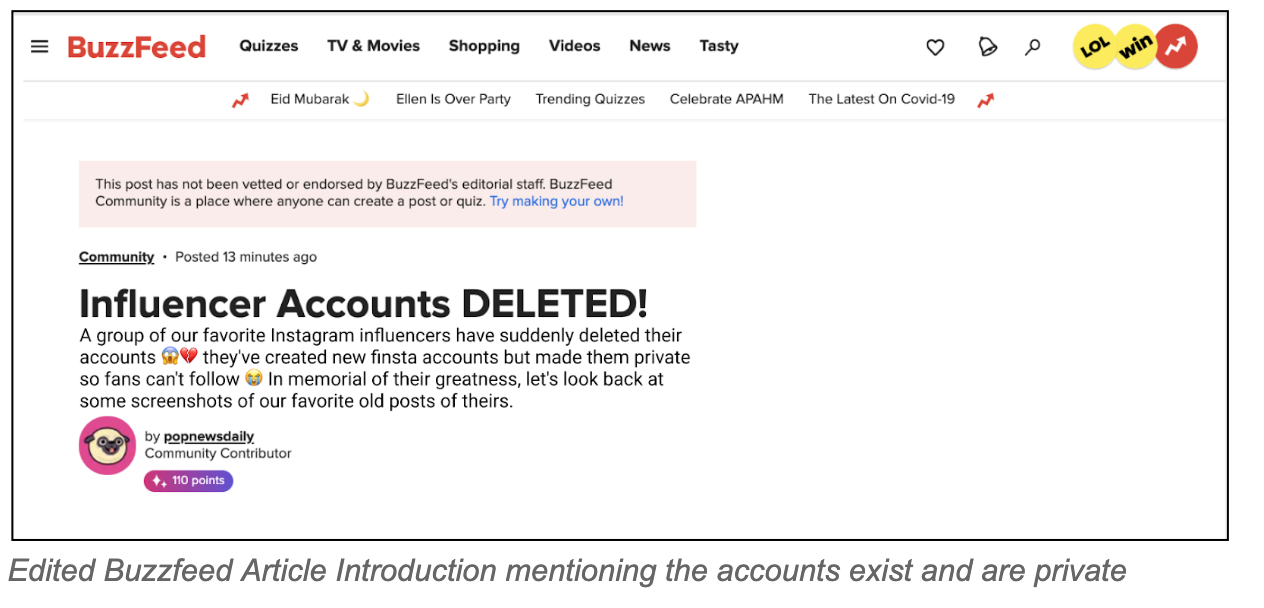
Checkpoint 2: Testable Core (5/17/21)
Feedback:
- The bot is a great way to disseminate information, and the thought process/motivations seem reasonable based on the playtests conducted (Even though the teaching team wasn’t able to access the Discord since the computer hosting the bot script had crashed and needed fixing)
Results:
- Affirmed we had made the right choice for the key platform.
In-Class Playtest 3 (5/20/21)
Observations:
- Players were confused by the fact that Bei (Danielle’s last name) was very similar to “bee.”
- The players spent a long time reading initial materials, which included the email, Buzzfeed article, and newspaper page.
- Players said that the Buzzfeed article and newspaper page looked realistic and made them feel like they were integrated into the story world.
Changes:
- We changed Danielle’s last name to Mei instead of Bei to distance it from “bee”
- We cut a large portion of the text in the initial reading materials: we made the newspaper article shorter and changed the prose summary of the case into a case file with bullet points.
Claus’s Playtest (5/21/21)
Observations:
- Player guessed the correct password of the Instagram account but didn’t include the exclamation point and was thus unable to log in to the account
- Player was confused by the relationship between “our sign” and the nickname “bee”
Changes:
- We changed “bee” to “b” to make the sign a clear single letter
- We removed the exclamation point from the password to the Instagram account to avoid confusion
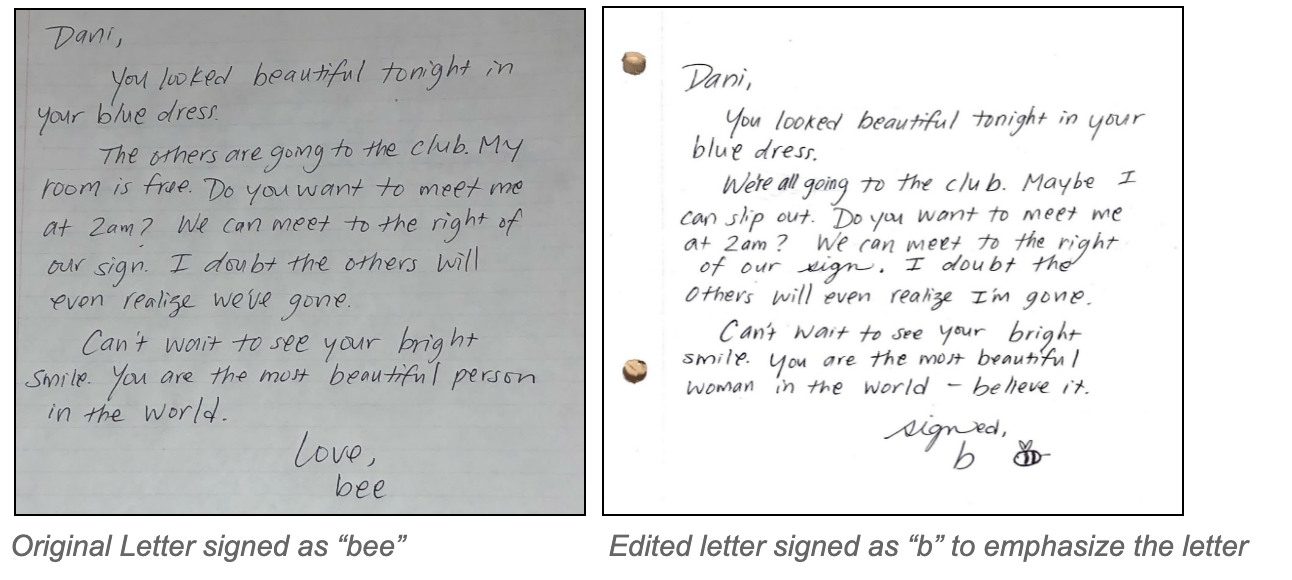
Mary’s Playtest (5/23/21)
Observations:
- Player couldn’t connect “sign” with “bee” and asked, “how’s a bee a sign?”
- He eventually got the solution but required a lot of help from the moderator repeating the hints “right of our sign” and “letter itself.”
- For people without a lot of experience in solving puzzles, it seems like it is not obvious at all what “to the right of our sign” means
- First, they have trouble realizing that Anthony and Danielle’s sign is a bee
- Then, they don’t know what location is to the right of “bee”
- Once a player got a hint, it still wasn’t enough to help them solve the puzzle sometimes.
Changes:
- Bolded all of the B’s in the letter so that it’s more obvious that B is important and so that the player is looking in the letter itself for the solution
- Added different tiers of hints: general, detailed, and the solution. This way if the general hint doesn’t unstick them, they can get a more detailed hint or the solution and finish the game without being too frustrated
Olivia’s Playtest (5/23/21)
Observations:
- After learning the solutions to the puzzles he didn’t solve, he was not satisfied. He explained that the exclamation point at the end of the dog’s name was not part of the name, disagreeing that that should be the solution
Changes:
- Changed the dog’s name to Lucy-Loo, which satisfies Instagram’s punctuation requirement while restricting the password to just the dog’s name.
Checkpoint 3: Refined Core or Slice (5/25/21)
Feedback:
- The narrative so far is fantastic.
- Use a format for the input instructions that is more clear.
- Maybe bold key terms in the email.
- It would be nice if before the game started there was some info of how the different platforms worked together.
Results:
- We bolded the input commands in all communication so that they would stand out. In addition, we included an onboarding level that would teach the player how to use the commands before the actual game started.
- We bolded the key terms in the email.
- We moved the information of how the platforms work together from the actual game to the onboarding level to prepare the player for what the game would entail.

Julia’s Playtest (5/26/21)
Observations:
- There were too many text blocks in the Tutorial with information the players did not immediately need to use.
- They struggled with the “bee” letter, but eventually got it correct, and said afterwards that “it was totally solvable” and they “should have gotten it earlier.”
Changes:
- We have changed the Tutorial so that the player must immediately use all of the information it presents.
- Affirmed our choice in bolding the “b” letter since it led the players to the correct answer. This was thus an appropriate level of challenge for the right target audience.

Andrea’s Playtest (5/26/21)
Observations:
- The player was not experienced in puzzle games at all and used all the available hints and two of the solutions
- He still had the fun “aha” moment when he got the solution but this game was likely too high above his skill level
Changes:
- Our target audience should be people who are advanced puzzle players
- Otherwise, they should expect to be using hints or spending a long time solving the puzzles
- Affirmed our First Order Optimal strategy since novice players can still get through the game by using hints and solutions.
In-Class Playtest 4 (6/1/21)
Observations:
- The players solved the first two puzzles, and were excited to continue the game! Sadly, we had run out of time.
- The players felt that the Tutorial was too long, especially for players who were already familiar with the game and the commands.
- A player mentioned that it wasn’t immediately clear that they were supposed to access Instagram. This echoed one playability feedback from the teaching team that it wasn’t obvious that they could go to the Instagrams.
Changes:
- Affirmed that our puzzles were now well balanced
- We introduced a skip tutorial command for players who didn’t need to learn the commands
- We decided to mention that players needed to use both Instagram and their emails in the onboarding stage. We also included a link to Danielle’s Instagram in the initial email to embed in the story that the finstas exist and are accessible.


Future Directions
We have written out the narrative of what happened to our missing person, Danielle. If we were to finish our game, we would implement part two, which would offer more puzzles and hints to discover that Danielle and her friends were part of a jewel-theft and a larger jewel crime ring. You can see the beginning elements of this narrative starting with the missing jewel article in the newspaper, which mentions turpentine. Then, looking through Anthony’s DMs shows a discussion with Emili about selling something and a conversation with Pierre who sends an article about how to remove turpentine from clothes. We have further planted hints about the jewels in the Instagram accounts, where Danielle and some of her friends showcase intricate jewelry and accessories. The setup for part two is ready, allowing us to continue developing puzzles and hints to reveal the story of what happened to Danielle.
Other models & materials
Moodboard
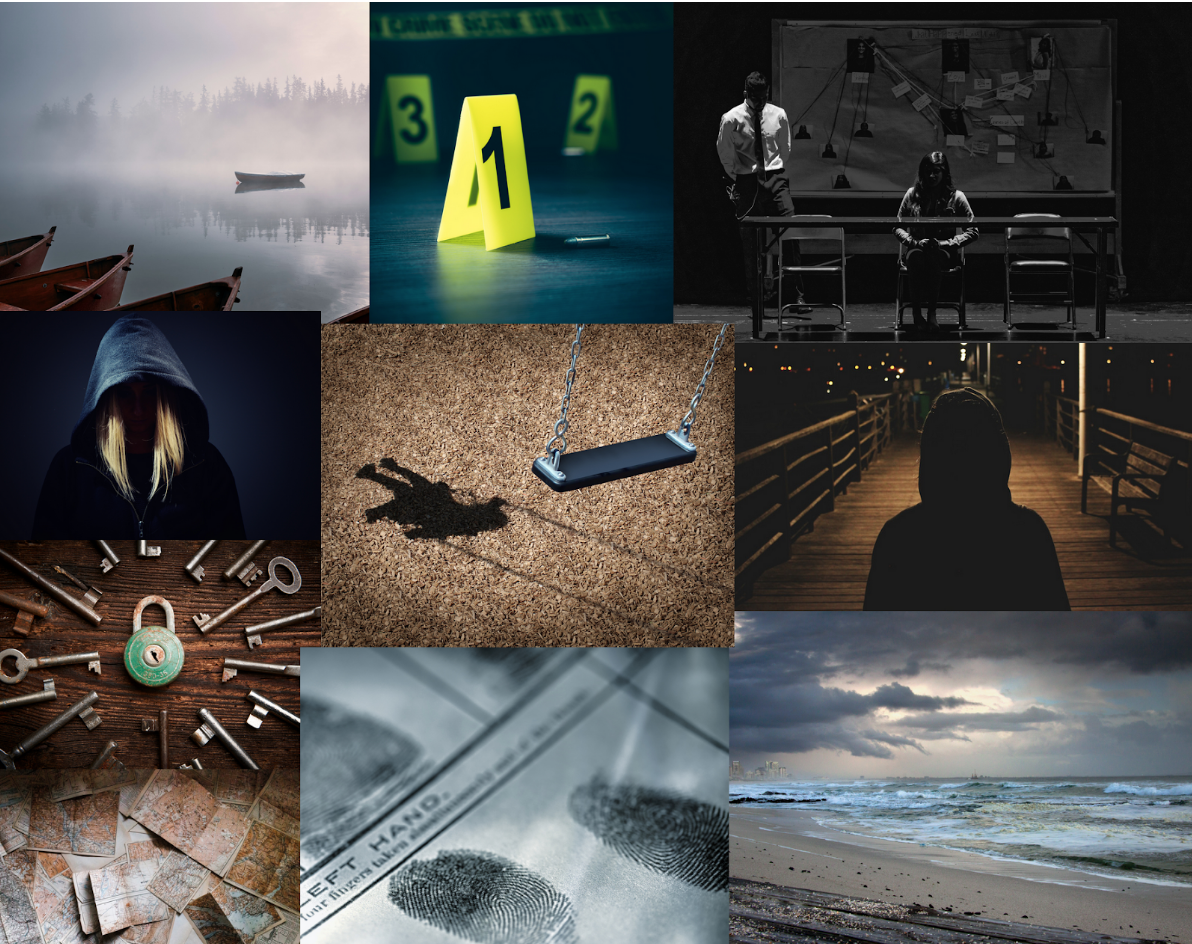
In-Game Music
https://open.spotify.com/playlist/2rn36ZA5Tuv6UBI6WT7R7V?si=f6791101e70b472e
Concept Map
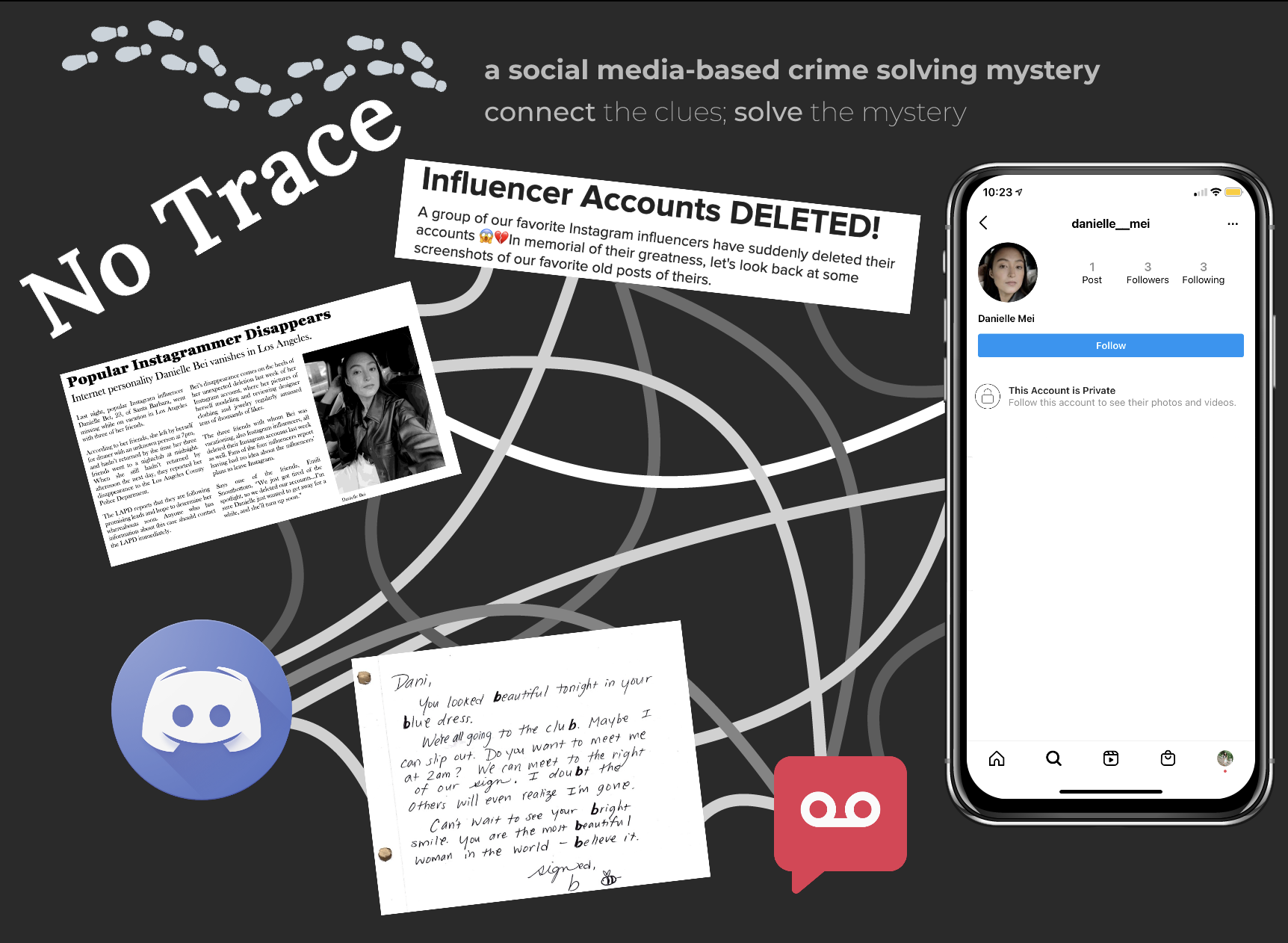
Game
Link to discord: https://discord.gg/gwk4BQhFMZ
To start playing the game, join the lapd-investigators voice channel, then type “start” within the lapd-investigators text channel.
Game Materials:
https://docs.google.com/document/d/1owJmbh7gyy5CwbU808-duVEWtmn0SozGOwiJqtaNdPg/edit?usp=sharing
Textual and Chronological Narratives (also linked in Narrative):
https://docs.google.com/document/d/1nuOc7OhBLSXdNr6LAu3CXk4ku8MN6Qdl7SF-WH5y6oQ/edit?usp=sharing
Recording of Playtest
https://drive.google.com/file/d/1zoTyIAV4Dl8pHKKNaXxI1y6lzpyIXyS7/view?usp=sharing


